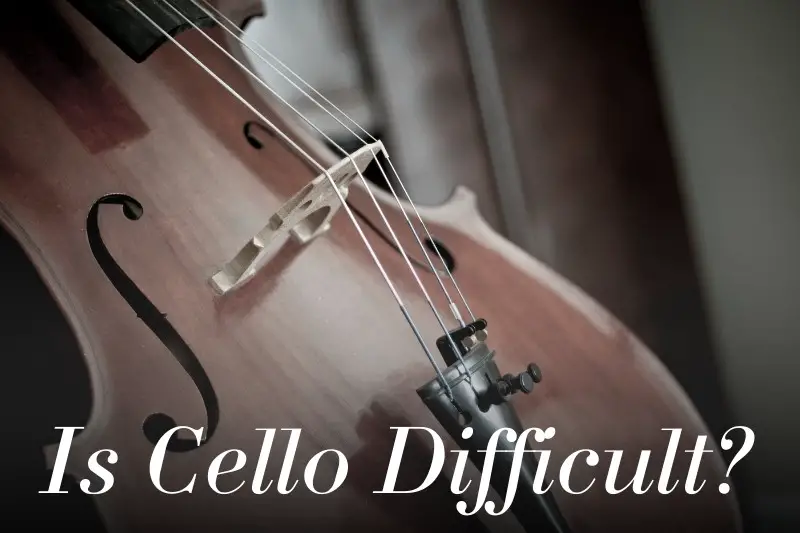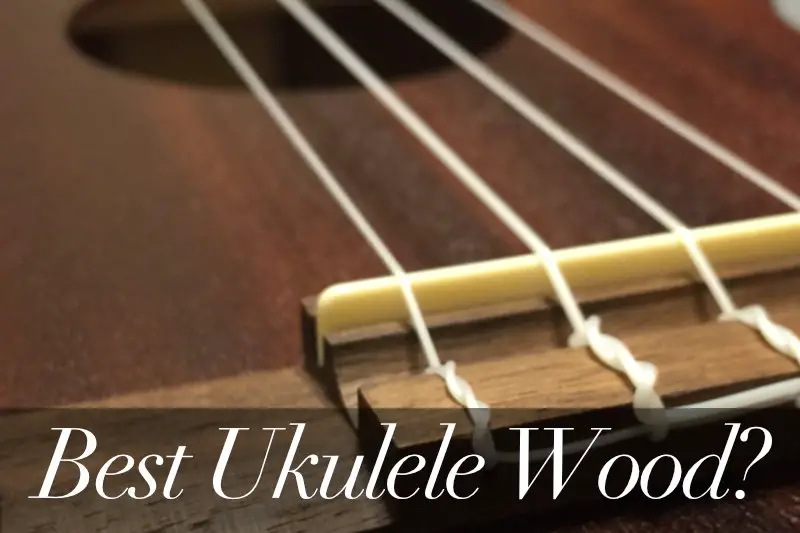The cello is such a gorgeous sounding instrument. It’s full, deep, and so soothing. It’s also one of the most popular string instruments in indie pop. It has a long history in orchestral music, and it’s important in genres like chamber pop as well. But, is cello hard to learn? Let me tell you a bit about my experience.
I found that the cello was pretty easy to learn as a beginner. The playing posture is relaxed and natural. The music doesn’t rely on breathwork, so you don’t have to practice breathing and how to use a mouthpiece. And, the availability of smaller-sized cellos make holding one comfortable for anyone.
I may be biased after playing cello for years starting as a child in middle school. But now, every time I hear the cello featured on a song, the low, round tones make me want to sit down and pick up right where I left off.
Some of the articles on our site contain affiliate links. We're careful about what we review and recommend. As an Amazon Associate, we may earn something small from qualifying purchases. Thanks for the support!
The cello was perfect for me because I love the lower register of string instruments, but I was a bit too small for the stand-up bass at the time. I picked up the trombone briefly in high school and could never figure out the correct embouchure!
So if you’re wanting to pick up an instrument, or you’ve already chosen the cello, here are some tips on starting out learning to play the cello!
1. Get the right equipment for your cello
Choose the right size cello for your body and your budget
There are a few items you’ll need to buy if you want to learn to play the cello. Of course, you’ll need to find the actual cello first. Since they can be expensive, just like so many other orchestral instruments, you can always see if your school or local music shop can lend or rent one to you. I borrowed a cello from my school for years when I first started playing.
Also, keep in mind that there are different sizes of cellos. So, do some research and find one that best fits you. Cello sizes that you’re likely to run into are between 4/4, which is considered a “full-sized” cello, all the way down to 1/10. This smallest size is often chosen for very young kids just starting out.
Your best bet is to go into a music store and sit with different sizes of cellos to see which one is the best fit.
If you or your child is still growing, think about how you might need a bigger size in the future. Sometimes, you might be comfortable enough with a cello that’s slightly larger than perfect if you know you or your child may grow into it rather quickly. But, it’s not a great idea to force a huge cello on a small player. The experience won’t be fun.
If you do start growing out of your cello but want to get a bit more use out of it before upgrading, you can always adjust the height that your cello sits by adjusting its endpin. Simply turn the peg on the bottom of the instrument and let the endpin fall so the cello sits at a comfortable place while you sit.
As you hold your cello comfortably, your left hand, which plays the notes on the neck, should be near your ear.
Cello accessories you’ll need
Your bow
In order to play, you’ll need a bow! Hopefully, your cello will come with a bow, and if you’re borrowing one from your school, they should definitely provide one. If you do need to buy one, an affordable bow will be just fine to start with.
Holding the bow correctly will take some practice. Your thumb should comfortably rest inside the curved part of the frog (the base of the bow). Your other four fingers should naturally fall on the outside of the other side of the frog. They should be spaced out and look like a very relaxed claw.
Find what’s most comfortable for you. You don’t want to cramp up while you play for long periods of time, so make sure your fingers aren’t tense. My index finger tended to be a little bit farther away from the other three fingers so that I could apply a little more pressure while playing.
Rosin
Though it’s not necessary, you can also buy some rosin to apply to your bow. Rosin is hardened tree sap, sometimes with other additives. When applied to the bow, it helps with friction to make your bow glide easily and your playing sound smooth.
Be careful, rosin can be messy! But, it can definitely make bowing easier when you learn to apply it just right.
A slipstop
In order to keep the endpin in place while you play, you’ll need a slipstop. These are little discs of rubber that keep the endpin from sliding on the floor while you play your cello. They are super cheap and super helpful!
Some sheet music – that you will LOVE
Sheet music from your favorite movies and bands is a great way to get you excited to practice. It really helps to have music that you love to play and listen to.
Go to your local music store, and sift through their music books. Cello music for beginners is usually very easy to find in music stores and online. The availability of cello sheet music is one thing that makes cello easier to learn for beginners.
I used to have the score for Harry Potter and the Chamber of Secrets, and I would practice it constantly! It made watching the movie that much more fun too since I could pick out the cello part and know what they were playing.
A music stand
Getting a music stand can make practicing much easier as well. It’s pretty essential, and I found a stand to be really helpful. I bought one that had two metal pieces that held the sheet music in place while I played. I liked this feature a lot, but it can be a hassle if your music is longer than two pages.
Tape
As a beginner, it can be hard to remember where the notes are on the neck since there are no frets. Tape can help with this! Taping where your index, ring, and pinky fingers should go is really common with players just starting out.
Though some might not like using tape and might see it as a crutch, it can help accelerate learning. Taking the tape off when you get used to the positioning will help to avoid relying on the tape later on.
2. Keep Your fingers and bow firm
Especially when you’re just beginning, you may have to press down harder than you think. With both your fingers and your bow. At first, I played fairly lightly, and the cello sounded weak and scratchy. When you play with power and confidence, you can hear it.
Start off by playing louder than you think is necessary, then cut it back until you have the right volume. You’ll need to press more firmly to get a louder sound, so this is good practice at the beginning.
Keep your fingers and bow firm and steady. I know that you might be shy to play too loudly at first, I was too. But, when you start out too strong and then dial it back, you’ll be able to see how hard you should be pressing the strings and bowing right off the bat.
3. Be ready to write in your music books
If this is your first time playing an instrument and you don’t know how to read music, don’t be afraid to write the letter names of the notes down in your music books! Similar to using tape on the neck of your cello, writing down the letters of the notes can make the learning curve at the beginning a lot easier.
At first, I used to write down what each note was above the musical notation. It helped me memorize all the notes quickly by association. Soon, I didn’t need to write down each note.
Later on, if you play in an orchestra, writing down little notes that your instructor tells you is super helpful too. They’ll probably encourage this! Maybe they will want to add a crescendo or emphasis on a specific note. Not everyone will remember those small details. So, always bring a pencil to rehearsal!
4. Experiment and listen
The only way to figure out what your favorite genres and techniques are is by experimenting! You won’t know if you like jazz or classical or contemporary pieces if you don’t play them. Look for different styles online or in music shops, and don’t be afraid of branching out from what is familiar to you.
Also, make different noises with your cello and see what happens. Try different bow techniques. Try bouncing your bow to get sounds from the strings. Definitely work on plucking notes with your fingers. As long as you don’t hurt your cello or your hands…don’t be afraid to experiment with different sounds.
You can also experiment with equipment. Try different strings for tone quality. See how different amounts of rosin affect your tone. There are lots of aspects of cello playing that you can play around with.
5. Make a practice plan and schedule – be consistent!
Planning your practice and learning, and sticking to that plan, is super important. You should always know what you’ll be practicing before you sit down to start. If you fiddle around with what scales or pieces you want to work on, you’ll waste valuable time that you could be actually playing.
Good cello education depends a lot on consistency. Be consistent with your schedule and practice. Consistency is key. If you play a bit here and there you may have a little fun, but you won’t level up your cello playing much at all.
Even if you spend hours on a Saturday practicing, but then leave your cello in the case the rest of the week, you’ll struggle to improve. Even 30 minutes a day, every day will allow you to improve your cello skills dramatically. Just be as consistent as you can, and stick to your plan.
Scale practice
As a beginner cellist, you want to make friends with practicing scales. It can seem really boring and tedious, but when you learn to challenge yourself with them it can be really fun. Gamify your practice whenever you can. See how many times you can get through a scale fluidly without any mistakes, or try to go just a little faster each time.
An important part of this type of practice is to remember that it’s just that, practice. When you mess up a scale, don’t beat yourself up. Just know it takes time, consistency, and effort to get better at scales. And they absolutely WILL help your actual cello playing.
Don’t go looking for instant gratification with scale practice. It’s more about how you improve over time. Think in terms of weeks rather than hours. This is the beginning of your cello journey, have fun with it.
Regular practice times
Making a set schedule on the clock can often help you stay consistent. Daily practice times that are the same from day to day will help you to develop a habit of practicing pretty quickly. You’ll come to expect that quality time with your cello, and you’ll miss it when you skip a session.
Study some music theory
Even a little bit of theory will go a long way towards developing your musical language. Beginner cello students are often really scared by music theory. But, it doesn’t have to be that way. Learning the circle of fifths and some key signatures is a great goal. Know what intervals are and what they mean.
Being able to speak the same language as other musicians is really fun and can cut down on frustration when dealing with cello teachers.
6. Manage your frustration
Don’t let yourself get down when it feels like you’re not improving as fast as you want to. Learning a new instrument can be challenging for anyone.
I know we’re answering the question, Is cello hard to learn? And, in relation to other instruments, I really do feel like it’s on the easier side. But, you will be frustrated.
When you start to feel frustrated, do something to take your mind off of it and come back to practicing later. Just make sure to give yourself a break when you need it.
7. Start slow and easy
Starting slow and easy when learning cello is really important. If you go really hard and play non-stop without giving yourself breaks, you’ll end up hurting your fingers or just burning out.
Your fingers will hurt. Your hand will cramp. It happens to us all. But, if you go nice and easy with practice at the beginning, you’ll make the entry a lot easier and less painful.
Also, if you always feel like you want to get back to practicing, you’ll create good habits around your schedule.
8. Listen to a lot of music with cello
During winter and spring breaks, I had band teachers give out “homework.” This homework ended up being listening to classical music. It exposed me to different styles and helped me appreciate classical music as a whole.
Hearing experts play will elevate your own playing. You’ll be able to hear the correct techniques as well as the passion behind their playing. Not to mention all the other benefits of listening to classical music. It can reduce stress and anxiety and can even alleviate pain!
But, thankfully, there’s also a lot of really great indie pop and chamber pop that features cello in absolutely lovely ways!
Learn about some famous cello players
When you start to listen to some professional cello players, you learn what’s possible at a very high level of cello playing. Virtuosos can take this gorgeous instrument and make incredible sounds with it. They can evoke any emotion, and they can draw you into a piece of music like you never thought possible.
In addition to the fun, you’ll have listening to these experts, their musical skills can be a great inspiration to you as you’re learning.
9. Have fun
This is both very obvious and super important. But, sometimes you have to remind yourself.
If you don’t remember to have fun while you’re practicing, you may forget why you wanted to learn to play cello in the first place. It’s a beautiful instrument. It makes lovely sounds, and you can play with other people too.
Practice shouldn’t be just long sessions of hard, boring work. It might get a bit tedious at times, so reminding yourself that, yeah, this is fun, is important.
Just keep in mind that you picked up the cello because you love the sound it makes, and it’s a blast to be able to be the one making those sounds.
Is cello hard to learn: Final thoughts
Yes, learning to play a musical instrument can be difficult. Is cello hard to learn? It depends on how you think about it. It will be a challenge; however, it’s a challenge I’ve found easier than other instruments I’ve learned. And it’s been well worth it.
There are other instruments that are great for beginners too, like the melodica or the ukulele. But, if you’re really passionate about the sound of the cello, jump in!
Cello is one of the prettiest, most soothing instruments out there. It’s one of my favorites because it feels so natural and fun to play. If you love the lower register and want to try out playing in an orchestra, definitely consider the cello.
One of the biggest things to keep in mind when starting out is to not be too shy. Play loud! Make some mistakes! That’s how you learn. You also learn from people who are better than you. Listen to the best players in the world.
Most importantly, have fun! Play the music that you want to play and that you’re interested in. Playing music is about creating and expressing. Don’t get caught up and disappointed in the little mistakes you make along the way. Enjoy the music you make!




